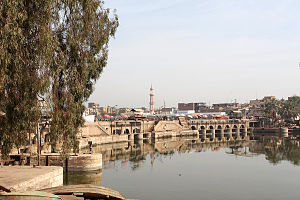Ibrahimiyya Channel
The Ibrahimiyya Canal ( Arabic الترعة الإبراهيمية at-Turʿat / at-Tirʿat al-Ibrāhīmiyya ) is an irrigation canal in Middle Egypt on the left bank of the Nile , whichbeginsin Asyut . The canal, which is around 350 kilometers long and completed in 1873, is one of the longest man-made canals. It carries about twice as much water as the Main and is used to irrigate about 6900 km 2 of land, which corresponds to about a fifth of the fertile land in Egypt. About five million people live on it.
History of the canal
The Ibrahimiyya Canal represents an important infrastructure project in Egypt , which served to irrigate and enlarge the cultivation area to the left of the Nile. With him, the irrigation methods were widely changed from seasonal irrigation in flood basins to year-round canal irrigation. The canal runs more or less parallel to the Nile. But it is no more than four to five kilometers from the river. The canal, begun in 1867 and completed in 1873 at the time of the Khedive (viceroy) Ismāʿīl Pasha , was once mainly used for year-round irrigation of the sugar cane fields. At times up to 100,000 workers were employed in the construction of the canal.
However, before the construction of the Aswan Dam, the canal's flow rate fluctuated between 30 and 80 cubic meters per second in summer and 500 to 900 cubic meters during the flood of the Nile. The irrigated area was about 2300 km 2 . With the completion of the Asyut weir, designed by the British civil engineer William Willcocks (1852-1932) in 1902, the flow rate of the canal could be better regulated. From 2012 to 2018, 7,000 workers built the 900-meter-long Asyut weir; it also contains two ship locks and a hydroelectric power station and was inaugurated in August 2018. To finance this construction project, which cost the equivalent of 470 million euros, KfW gave a loan of around 300 million euros.
Course of the canal
The canal begins with the canal weir in Asyut and after 60 kilometers runs over Dairut , where the Ibrahimiyya Canal and the like. a. It is divided into the Joseph Canal to the west, the Bahr Yusuf , and the Ibrahimiyya Canal to the east, further via Mallawi at kilometer 90, al-Minya at kilometer 120, Matai at kilometer 160, Maghagha at kilometer 190, al-Sharahna at kilometer 210 and Bani Suwaif , until it flows back into the Nile at el-ʿAyat at km 350 .
There are country roads on both sides of the canal. On the right-channel side in a more or less large distance from the railway line runs Cairo to Aswan .
Water distribution facilities
The canal weir in Asyut ( Arabic كوبري الترعة الإبراهيمية Kūbrī at-Turʿat al-Ibrāhīmīya 'Bridge of the Ibrāhīmīya Canal') is about 100 meters long and has nine openings.
The Dairut weir ( Arabic قناطر ديروط Qanāṭir Dairūṭ 'Dairut Dam') is the most important and technically most complex facility on the canal. The water is divided over six individual weirs. The two main drains are the Bahr Yusuf and the continuation of the Ibrahimiyya Canal.
Further weirs are in Mallawi, the Hafiz weir, in al-Minya, the Minya weir, in Matai, the Matai weir, in Maghagha, the Maghagha weir, and in al-Scharahna, the Scharahna weir.
literature
- William Willcocks, James Ireland Craig: Egyptian Irrigation Volume I ; Egyptian Irrigation Volume II. 3rd edition. Spon, London / New York 1913.
- Julien Barois, Alexander Macomb Miller (transl.): Irrigation in Egypt . Government Printing Office, Washington 1889, p. 38 f . ( archive.org ).
Individual evidence
- ↑ a b c d Christoph Albrecht-Heider, Sebastian Jacobi: The new Asyut weir over the Nile ensures water supply for five million Egyptians. Infrastructure: mammoth construction for smallholders. In: KfW> Stories> Economy> Infrastructure. KfW, October 22, 2018, accessed on September 6, 2019 (information such as 690,000 hectares of land, five million people and total costs of 470 million euros in the video on the page).
Coordinates: 27 ° 11 ′ 46.9 ″ N , 31 ° 11 ′ 18 ″ E


